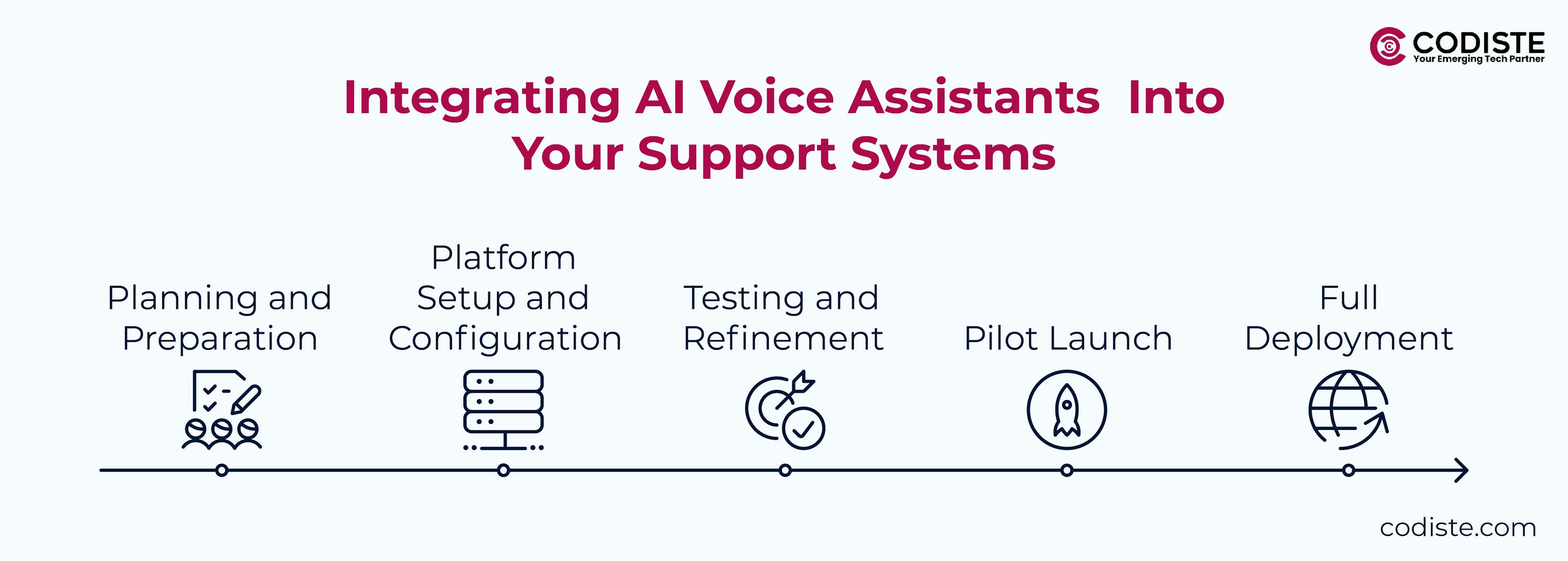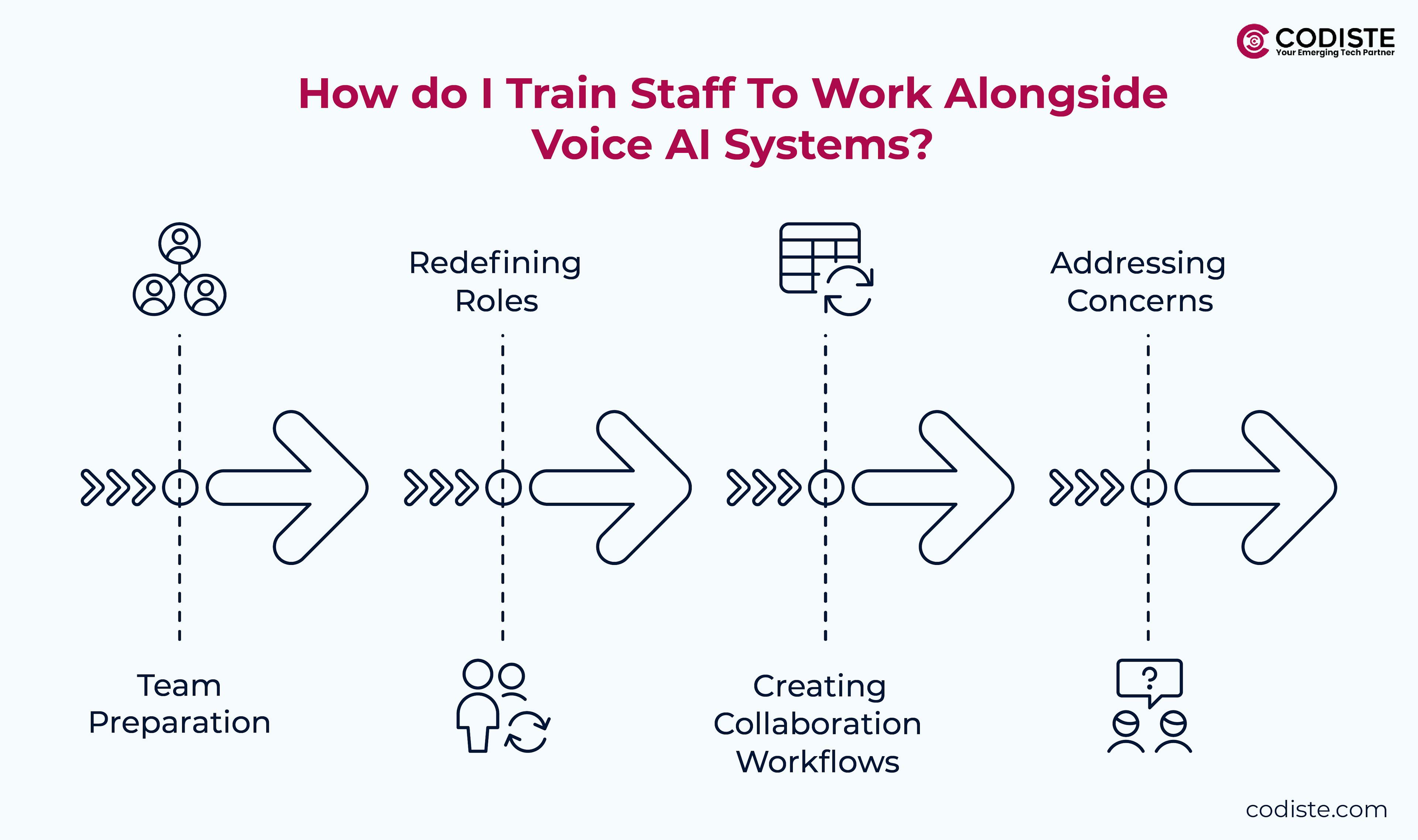


The turning point in the evolution of customer service has been attained. AI voice assistants have become an exciting option as businesses work to fulfill the increasing demands of their clientele for immediate, individualized assistance. AI voice assistants may alter how a company reacts to client demands because they provide a more conversational, organic experience than traditional chatbots, which rely on text-based interactions.
It's not only about implementing AI voice integration into your current customer support system; it's also about delivering a smooth, effective experience that benefits your customer service automation and your support staff. This all-inclusive manual will guide you through every step of the integration process, from preliminary preparation to complete implementation. Let's get started.
AI voice assistants are advanced devices that comprehend and react to consumer inquiries via voice interactions by utilizing speech recognition, machine learning, and natural language processing (NLP). Contemporary AI voice assistants are capable of dynamic dialogue, context understanding, and personalized responses, in contrast to basic interactive voice response (IVR) systems that depend on menu navigation.
From processing orders and responding to often asked queries to setting up appointments and supplying account information, these systems are capable of managing a broad variety of customer support duties. Without the constraints of human agents, they can manage numerous client interactions at once, provide constant service quality, and operate around the clock.
AI voice assistants reduce annoyance and hold times by responding to consumer questions instantly. A more natural and fulfilling contact experience is produced when customers can converse without having to navigate complicated menu systems.
The use of AI voice assistants lowers operating expenses by automating regular questions and basic support functions. Because they can manage several calls at once, you don't need as many human agent teams, and your current employees can concentrate on high-value, complex interactions.
AI voice assistants never demand breaks, holidays, or sleep, in contrast to human agents. Customers may access assistance anytime they need it, regardless of time zones or office hours, thanks to their reliable support coverage.
AI voice assistants may manage more volume at busy times or unanticipated spikes in consumer requests without requiring more labor or causing service degradation. This scalability is especially beneficial for companies that experience quick growth or seasonal changes.
Every conversation a customer has with an AI voice assistant produces useful information about their preferences, typical problems, and service trends. This data can help you develop your business and make the most of your overall customer service automation plan.
Examine your existing customer care system in detail before implementing AI voice assistance. Keep track of your current call traffic, response times, typical enquiry formats, and metrics related to customer satisfaction. Determine issues like prolonged wait times, time-consuming repetitive requests, or gaps in after-hours help.
Examine your client service records to identify which encounters can be automated with AI. Status queries, simple troubleshooting, appointment setting, and information requests are typical examples of these. Keep an eye out for trends in customer calls that point to regular, predictable exchanges that don't demand for emotional assistance or intricate decision-making.
For your AI voice integration, establish clear, quantifiable objectives. These could be lowering operating expenses, raising customer satisfaction ratings, improving first-call resolution rates, or cutting the average call handling time by 30%. Having specific goals will help you measure performance and direct your integration plan.
Take into account both the upfront implementation costs and continuing operating expenditures. Include expenditures for staff training, integration services, hardware specifications, software license, and upkeep. Long-term cost reductions usually outweigh the initial investment, even though it may be substantial.
Say Goodbye to Long Wait Times by Implementing AI Voice Agents Now!
A cross-functional team of IT, customer support, and business stakeholders should be assembled first. Specify the timeframe, success metrics, and scope of your integration. Make a thorough project plan with clearly defined tasks and milestones.
To determine whether your current infrastructure needs any improvements or alterations, do a technical assessment. This entails assessing your data storage capacity, CRM integration points, and phone system.

Begin with the most fundamental platform setup, which includes creating an account, learning how to speak, and writing simple response scripts. Make sure data moves between platforms correctly by configuring integration connections with your current systems.
Start with basic, high-volume conversations to develop your initial conversation flows. Create backup plans in case the AI is unable to respond to a query, guaranteeing seamless transfers to human operators.
Test thoroughly using a range of scenarios, accents, and query kinds. To guarantee data correctness and system stability, test every integration point. To find any problems and get input, include your customer support staff in the testing process.
Adjust replies, increase recognition accuracy, and improve user experience by refining conversation flows in reaction to test findings. To achieve optimal performance, this iterative approach is essential.
Implement the AI voice assistant for a small subset of customers or particular use cases. Keep a careful eye on performance, monitoring important indicators including system dependability, resolution rates, and customer satisfaction.
During the pilot stage, get input from agents and customers. Prior to full deployment, use this feedback to make any last-minute changes.
Throughout the first few weeks, carefully monitor the rollout of the AI voice assistant to your whole consumer base. Ascertain that there is a sufficient backup of human agents to manage any unforeseen problems.
Put in place continuous optimization and monitoring procedures, analyzing performance indicators frequently and adjusting as necessary.
Enhance Customer Satisfaction Effortlessly, Deploy Your AI Agents Today!
The majority of recent AI voice platforms offer strong APIs for system interaction. To guarantee smooth data transfer between the AI platform and your CRM, help desk software, and other business systems, collaborate with your IT staff or integration partners.
To safeguard client information during voice conversations, have robust security measures in place. This includes storing chat logs securely, encrypting voice data, and adhering to applicable privacy laws like the CCPA or GDPR.
Consider future expansion when designing your integration. As your AI voice assistant's capabilities grow, be sure your infrastructure can support more features and higher call volumes.
Use failover techniques to guarantee ongoing service availability. If the AI platform is unavailable, this provides contingency plans and explicit escalation routes to human agents.
Offer your AI assistant an extensive training set of client enquiries, responses, and business terms. Find the most common interactions and best responses using previous customer service data.
Create natural conversation flows to help consumers resolve issues while accommodating unanticipated questions. These flows should be conversational and reflect your brand's tone.
Execute constant AI training applying real customer interactions. Every update and refinement makes your AI helper smarter, learning from triumphs and failures.
Make sure your AI assistant speaks your company's language and ideals. The tone, linguistic style, and formality suited for your audience are included.
Your customer support personnel must be trained on how the AI voice assistant works, when it escalates calls to human agents, and how to handle these escalated encounters. This AI-to-human handoff training should include technical and soft skills.

Help your staff understand how AI integration will shift their tasks from simple questions to complex problem-solving and connection-building. Reducing monotony and increasing agents' skills might enhance job satisfaction.
Clarify AI-human agent collaboration protocols. This incorporates AI performance feedback, escalation triggers, and handoff protocols.
Any worries regarding job security or shifting duties should be addressed, and the integration process should be made clear. Stress that rather than taking the place of human abilities, AI will improve them.
Hold a tab on key performance indicators, including average handling time, cost per interaction, call resolution rates, and customer satisfaction ratings. To gauge progress, compare these indicators before and after integrating AI agent.
Establish a methodical procedure for gathering consumer opinions regarding their interactions with AI voice assistants. For spotting areas for improvement and guaranteeing client satisfaction, this input is priceless.
Evaluate AI performance on a weekly or quarterly basis, noting trends, achievements, and areas that need work. Optimise system performance, update training data, and improve conversation flows with this data.
Create continuous steps to enhance AI, such as updating conversation flows regularly, extending capabilities, and incorporating new features as they become available.
Determine the immediate cost savings from lower training expenses, more efficient operations, and less time spent by agents on routine questions. To calculate net savings, account for the expenses of AI platform maintenance and license.
Track customer retention rates, promoter scores, and customer satisfaction levels to gauge how integrating AI has affected the customer experience. Enhancements in these areas frequently result in higher client lifetime value and income.

Track gains in first-call resolution rates, average handling time, and overall support staff productivity. These efficiency benefits frequently compound over time, as the AI system learns and improves.
Consider how AI voice helps promote business growth by offering scalable customer support that can scale with your company without requiring equal increases in staffing.
Challenge: Connecting AI voice systems with existing infrastructure can be technically complex.
Solution: Before extending functionality, begin with basic use cases and collaborate with knowledgeable integration partners.
AI voice integration into your customer support infrastructure can improve customer experience and operational efficiency. All you need is effective planning, implementation, and optimization capabilities.
To integrate AI voice assistant, one must first understand how powerful this tool is when it comes to customer service automation and its ability to enhance your team's capabilities. When properly deployed, AI voice assistants handle basic enquiries while freeing up human agents to undertake complicated, high-value interactions that involve empathy, creativity, and problem-solving. With the right strategy and execution, AI voice agent help may turn customer care into a competitive advantage that boosts customer happiness and corporate success.
Communication, intelligence, and 24/7 availability are the future of customer service. By adding AI voice assistance today, you're tackling existing problems and preparing for the future customer experience revolution, and Codiste can help you achieve that with ease. With over 40+ AI agents made to date, we are here to offer you the answer you need. Connect here for all your requirements.




Every great partnership begins with a conversation. Whether you’re exploring possibilities or ready to scale, our team of specialists will help you navigate the journey.